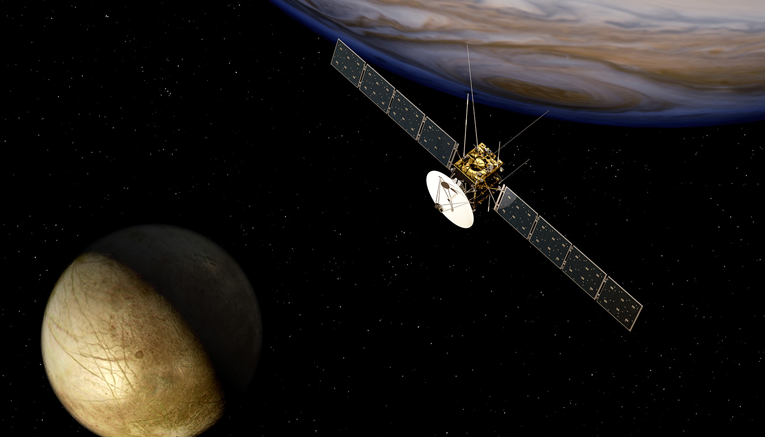Orbits ESA’s JUICE space mission
On 13 April, Ariane 5, operated by Arianespace, completed a flawless launch on its 116th flight from the Guiana Space Centre (CSG), Europe’s spaceport in Kourou, sending the JUICE space mission (JUpiter ICy moons Explorer) on its voyage of more than seven-years to the planet Jupiter. This launch is the first in 2023 from the CSG and the first of the year for Ariane 5. It is also the 260th flight in the Ariane series.
JUICE is a flagship ESA mission conceived under the agency’s Cosmic Vision 2015-2025 programme.
There are 15 European countries, as well as Japan, the United States, Canada and Israel, involved in this mission. JUICE is the first European space probe to venture this far out into the solar system. On reaching its destination in 2031, JUICE will spend three and a half years studying Jupiter and its three icy moons:
Ganymede—the largest moon in the solar system, harbouring a vast icy ocean and a magnetosphere— Callisto and Europa. The mission’s main goals are to investigate the moons’ potential habitability, i.e., to determine whether the conditions to support life might exist there, to acquire new data on how the solar system and planets formed, and to characterize Jupiter’s magnetosphere and how it interacts with its moons.
JUICE is carrying 10 scientific instruments. France is contributing to six1 through laboratories affiliated to the French national scientific centre CNRS and its partners, with CNES providing oversight:
- MAJIS (Moons and Jupiter Imaging Spectrometer), an infrared spectrometer to characterize the
surface of Jupiter’s moons (lead IAS with contributions from LESIA, France, IAPS, Italy, and ROB,
Belgium) - PEP (Particle Environment Package, SNSB, Sweden/contribution from IRAP, France)
- RIME (Radar for Icy Moons Exploration, ASI, Italy/contribution from IPAG, France)
- RPWI (Radio & Plasma Wave Investigation, SNSB, Sweden/contributions from LESIA-LPP-LPC2E-
IRAP, France) - SWI (Sub-millimetre Wave Instrument), a heterodyne radiotelescope to probe the atmosphere (Max
Planck Institute, Germany/contributions from LERMA-LAB-C2N, France) - UVS (UV Imaging Spectrograph, NASA, USA/contribution from LATMOS, France)
- JANUS optical camera (ASI, Italy)
- J-MAG (Magnetometer for JUICE, United Kingdom Space Agency (UKSA))
- GALA (Ganymede Laser Altimeter) to study the moons’ morphology and topography (DLR,
Germany)
1 The French research laboratories contributing to the JUICE mission are: the IAS space astrophysics institute (CNRS/Paris-Saclay University), the LESIA space and astrophysics instrumentation research laboratory (Paris Observatory- PSL/CNRS/Sorbonne University/Paris-Cité University), the IRAP astrophysics and planetology research institute (CNES/CNRS/Toulouse III University), the IPAG planetology and astrophysics institute in Grenoble (CNRS/UGA), the LPP plasma physics laboratory (CNRS/Ecole Polytechnique/SU), the LPC2E environmental and space physics and chemistry laboratory (CNES/CNRS/University of Orleans ), the LERMA astrophysical and atmospheric radiation and matter research laboratory (Paris Observatory – PSL/CNRS/SU/CY Cergy Paris University), the LAB astrophysics laboratory in Bordeaux (CNRS/University of Bordeaux), the C2N nanosciences and nanotechnologies centre (CNRS/Paris-Saclay University), the LATMOS atmospheres, environments and space observations laboratory (CNRS/SU/UVSQ) and the LPG planetology and geoscience laboratory (CNRS/University of Nantes/University of Angers). - 3GM radiometers (Gravity & Geophysics of Jupiter and Galilean Moons, ASI, Italy)
France is contributing to the mission through 10 research laboratories affiliated to CNRS and its partners, notably the Paris Observatory – PSL, plus the Ecole Polytechnique engineering school and 11 universities from all over the country, which have worked on developing the science instruments, mainly MAJIS. This infrared spectrometer is designed notably to characterize the surface of Jupiter’s moons. It is supplied by the IAS space astrophysics institute, a research laboratory of CNRS and Paris-Saclay University in Orsay, in partnership with CNES. - CNES is also supporting other French research laboratories that worked to develop JUICE’s scientific
instruments. The agency is funding industrial contracts for all of the French contributions, for MAJIS and the
laboratories working on the five other instruments, and its field centre is providing a range of expertise (EMC,
surface-mounting techniques, reliability, flight software, etc.).
Commenting on the launch, CNES Chairman & CEO Philippe Baptiste said: “Yet another success for Ariane 5! Europe is once again heading into space and showing its renowned science and engineering prowess. I would like to congratulate and thank all of the partners to whom we owe this success, and all of the teams for their professionalism and expertise, at ESA, Arianespace, across the European space industry and academia, and of course the people at CNES’s four field centres who have worked so hard on this mission.
Now that CNES’s Space Transportation Directorate and Guiana Space Centre have accomplished their mission, the Toulouse Space Centre and subject matter experts at Head Office in Paris Les Halles will now be taking the lead alongside ESA’s science teams for the long cruise phase to Jupiter. We look forward to when JUICE enters its observation phase to study Jupiter and its three icy moons in seven years’ time.”
“Well done and thank you ESA, Arianespace and CNES for this new success,” added CNRS Chairman & CEO Antoine Petit. “Congratulations to the teams at CNRS and partner laboratories who have worked to make this mission to Jupiter happen. It is the result of a 10-year development effort in our laboratories that is set to shed new light on how giant planets form and on the potential habitability of Jupiter’s icy moons.
Solving the mystery of the origins of life is precisely central to one of the ambitious research programmes
that CNRS is leading under the France 2030 plan.” Source: CNES






Be the first to comment on "New launch success for Ariane 5"